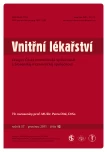Complications of endoscopic retrograde cholangiopancreatography and how to minimize them
Authors:
A. Vavrečka
Authors‘ workplace:
Gastroenterologická klinika Lekárskej fakulty Slovenskej zdravotníckej univerzity a UN Bratislava, Slovenská republika, prednosta doc. MUDr. Marian Bátovský, CSc., mim. prof. SZU
Published in:
Vnitř Lék 2011; 57(12): 1053-1056
Category:
70th birthday of prof. MUDr. Petr Dítě, DrSc.
Overview
Endoscopic retrograde cholangiopancreatography in the recent past was one of the basic diagnostic and therapeutic methods of several biliary and pancreatic diseases. It was and is still associated with several complications that can lead to exit the patient and is therefore considered invasive methods. The most serious complications include acute pancreatitis and acute cholangitis. Bleeding and perforation may complicate papillosphincterotomy that precedes another performance (extraction of stones, drainage of biliary and pancreatic duct. The incidence of serious complications have led to efforts to reduce the number of ERCP. This allowed in particular the introduction of new diagnostic methods, especially MRCP and EUS, which led to the practical exclusion of diagnostic ERCP. At present, ERCP is considered to be purely therapeutic method. In addition, considerable experience has been published to reduce the incidence of complications in ERCP. Many of them can be applied to our clinic, which has experience of more than 10 000 ERCP performed.
Key words:
ERCP – complications – risk factors
Sources
1. Classen M, Demling L. Endoskopische sphinkterotomie der papila Vateri und steinextraktion aus dem ductus choledochus. Dstch Med Wochenschr 1974; 99: 496–497.
2. Kawai K, Akasaka Y, Murakami K et al. Endoscopic shincterotomy of the ampulla of Vater. Gastrointest Endosc 1974; 20: 148–151.
3. Soehendra N, Reijnders-Frederix V. Palliative bile duct drainage. A new endoscopic method of introducing a transpapilary drain. Endoscopy 1980; 12: 8–11.
4. Laurence BH, Cotton PB. Decompression of malignant biliary obstruction by duodenoscope intubation of the bile duct. Br Med J 1980; 280: 522–523.
5. Cotton PB, Leung JWC. Advanced Digestive Endoscopy: ERCP. Oxford: Blackwell Publishing 2006: 416.
6. Freeman ML, Guda NM. Prevention of post-ERCP pancreatitis: a comprehensive review. Gastrointest Endosc 2004; 59: 845–864.
7. Glomsaker T, Søreide K, Hoff G et al. Contemporary use of endoscopic retrograde cholangiopankreatography (ERCP): A Norwegian prospective, multicenter study. Scand J Gastroenterol 2011; 46: 1144–1151.
8. Cotton PB. Analysis of 59 ERCP lawsuits; mainly about indications. Gastrointest Endosc 2006; 63: 378–382.
9. Cotton PB. ERCP: Risk, Prevention, and Management. In: Cotton PB, Leung JWC (eds). Advanced Digestive Endoscopy: ERCP. Oxford: Blackwell Publishing 2006: 339–386.
10. Cheng CL, Sherman S, Watkins JL et al. Risk factors for post-ERCP pancreatitis: a prospective multicenter study. Am J Gastroenterol 2006; 101: 139–147.
11. Bailey AA, Bourke MJ, Kaffesw AJ et al. Needle-knife sphincterotomy: factors predicting its use and the relationship with post-ERCP pancreatitis. Gastrointest Endosc 2010; 71: 266–271.
12. Cennamo V, Fuccio L, Zagari RM et al. Can a wire-guided cannulation technique increase bile duct cannulation rate and prevent post-ERCP pancreatitis? A meta analysis of randomized cotrolled trials. Am J Gastroenterol 2009; 104: 2343–2350.
13. Cheung J, Tsoi KK, Quan WL et al. Guidewire versus conventional contrast cannulation of common bile duct for the prevention of post-ERCP pancreatitis: a systematic review and meta-analysis. Gastrointest Endosc 2009; 70: 1211–1219.
14. Pan XP, Dang T, Meng XM et al. Clinical study on the Prevention of Post-ERCP Pancreatitis by Pancreatic duct stenting. Cell Biochem Biophys 2011 [Epub ahead of print].
15. Fazel A, Quadri A, Catalano MF et al. Does a pancreatic duct stent prevent post-ERCP pancreatitis? A prospective randomized study. Gastrointest Endosc 2003; 57: 291–294.
16. Zhou W, Li Y, Zhang Q et al. Risk factors for Postendoscopic Retrograde Cholangiopancreatography Pancreatitis. A Retrospective Analysis of 7 168 Cases. Pancreatology 2011; 11: 399–405.
17. Vavrečka A. Gastrointestinálna endoskopia. Bratislava: HERBA 2004: 124.
18. Freeman ML. Toward improving outcomes of ERCP. Gastrointest Endosc 1998; 48: 96–102.
19. Baron TH. Covered self-expandable metal stents for benign biliary tract disease. Cur Opin Gastroenterol 2011; 27: 262–267.
20. Vavrečka A. Minulosť, súčasnosť a budúcnosť gastrointestinálnej endoskopie. Lek obz 2003; 52: 157–159.
21. Petersen S, Henke G, Freitag M et al. Management of hemorhage and perforation following endoscopic sphincterotomy. Zentrabl Chir 2001; 126: 805–809.
22. Freeman ML, Nelson DB, Sherman S et al. Complications of biliary sphincterotomy. N Engl J Med 1996; 335: 909–918.
23. Enns R, Eloubeidi MA, Mergener K et al. ERCP related perforations: risk factors and management. Endoscopy 2002; 34: 293–298.
24. Stapfer M, Selby RR, Stain SC et al. Management of duodenal perforation after endoscopic retrograde cholangiopancreatography and sphincterotomy. Ann Surg 2000; 232: 191–198.
25. Freeman ML, DiSario JA, Nelson DB et al. Risk factors post-ERCP pancreatitis: A prospective, multicenter study. Gastroentest Endosc 2001; 54: 425–434.
26. Ersoz G, Tekesin O, Ozutemiz AO et al. Biliary sphincterotomry plus dilatation with a large balloon for bile duct stones that are difficult to extract. Gastrointest Endosc 2003; 57: 156–159.
27. van Boeckel PG, Vleggaar FP, Diersema PD. Plastic or metal stents for benign extrahepatic biliary strictures: a systematic review. BMC Gastroenterol 2009; 9: 96.
28. Dítě P, Ružička A, Zbořil V et al. A prospective, randomized trial comparing endoscopic versus surgical therapy of chronic pancreatitis. Endoscopy 2003; 7: 553–558.
Labels
Diabetology Endocrinology Internal medicineArticle was published in
Internal Medicine

2011 Issue 12
Most read in this issue
- Neuroendocrine tumours of the upper gastrointestinal tract, characteristics and comparison of localization diagnostics
- Complications of endoscopic retrograde cholangiopancreatography and how to minimize them
- Aldosterone as an endogenous cardiovascular toxin and the options for its therapeutic management
- Do we need endoscopic sclerotherapy of oesophageal varices or the last turn off the light
